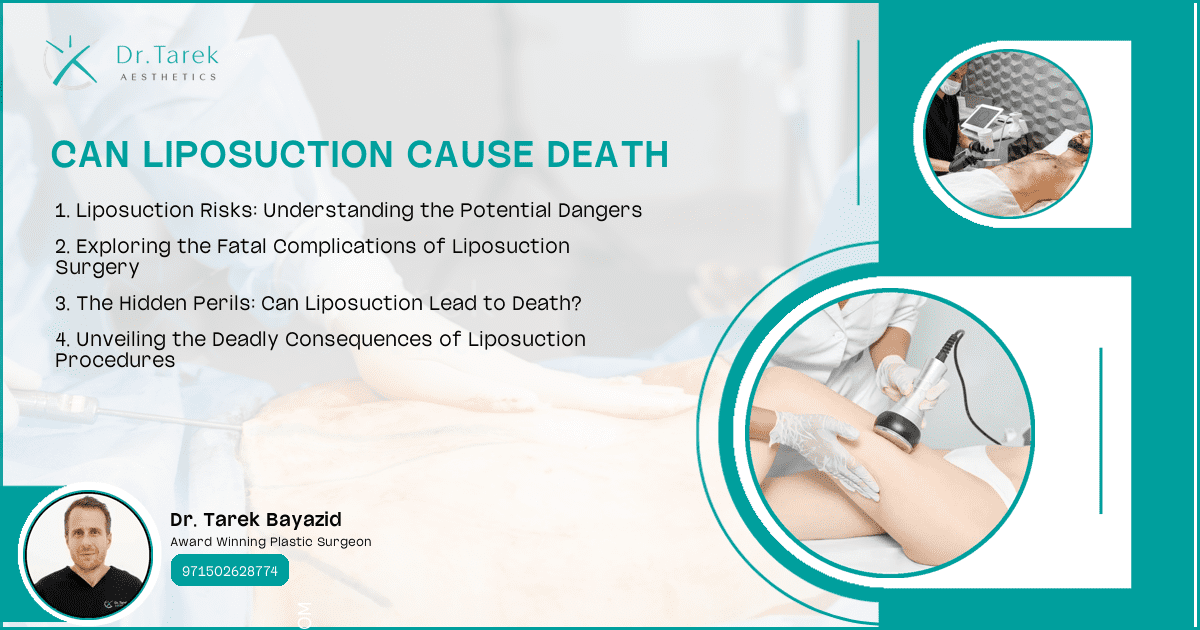Can Liposuction Cause Death?
Liposuction is a popular cosmetic procedure that involves removing excess fat to contour the body. While generally safe, it carries inherent risks. Complications can arise from the surgery itself or the anesthesia used. Understanding these risks is crucial for anyone considering the procedure.
- Infection : Post-surgical infections can occur, leading to severe complications if not treated promptly.
- Bleeding : Excessive bleeding during or after the procedure can pose significant health risks.
- Scarring : Unfavorable scarring can result from the procedure, affecting the aesthetic outcome.
Mortality Rates Associated with Liposuction
The mortality rate for liposuction is relatively low but not negligible. According to a study published in Plastic and Reconstructive Surgery, it is approximately 1 in 5000 procedures (0.02%). This statistic underscores the importance of understanding the potential risks involved.
- Pulmonary Embolism : A blood clot that travels to the lungs can be fatal.
- Fat Embolism : Fat particles entering the bloodstream can cause blockages in vital organs.
- Anesthesia Complications : Adverse reactions to anesthesia can lead to severe outcomes, including death.
Comparing Traditional Liposuction vs. VASER Lipo Safety
Traditional liposuction and VASER lipo both aim to remove fat but differ in technique and safety profiles. VASER lipo uses ultrasound technology to break down fat, which is then suctioned out. This method is generally considered safer due to its precision and reduced trauma to surrounding tissues.
Book A Consultation With Dr Tarek Bayazid
Top-rated Plastic Surgeon For Liposuction in Dubai
Installment Plan Available
- Reduced Trauma : VASER lipo causes less damage to blood vessels and nerves.
- Faster Recovery : Patients often experience quicker recovery times with VASER lipo.
- Lower Complication Rates : The targeted approach of VASER lipo reduces the risk of complications.
Potential Complications Leading to Fatalities in Liposuction
Pulmonary Embolism and Fat Embolism
Pulmonary embolism and fat embolism are serious complications that can lead to death. A pulmonary embolism occurs when a blood clot travels to the lungs, blocking blood flow. Fat embolism happens when fat particles enter the bloodstream and obstruct blood vessels in critical organs.
- Symptoms : Shortness of breath, chest pain, and rapid heart rate.
- Prevention : Early mobilization and anticoagulant medications can help prevent these conditions.
- Treatment : Immediate medical intervention is crucial for survival.
Anesthesia-Related Complications
Anesthesia is a critical component of liposuction, but it carries its own set of risks. Adverse reactions to anesthesia can range from mild to severe, including allergic reactions, respiratory issues, and even cardiac arrest.
- Monitoring : Continuous monitoring of vital signs during surgery is essential.
- Pre-Screening : Thorough pre-screening for allergies and medical history can mitigate risks.
- Emergency Protocols : Having emergency protocols in place can save lives.
Infection and Sepsis
Infections can occur at the incision sites or internally, leading to sepsis, a life-threatening condition. Proper sterilization techniques and post-operative care are vital to prevent infections.
- Signs of Infection : Redness, swelling, and fever.
- Antibiotics : Prophylactic antibiotics can reduce the risk of infection.
- Hygiene : Maintaining good hygiene post-surgery is crucial for recovery.
Factors Increasing Risk of Death from Liposuction
Patient Health and Pre-Existing Conditions
The overall health of the patient plays a significant role in the risk associated with liposuction. Pre-existing conditions like heart disease, diabetes, and respiratory issues can increase the likelihood of complications.
- Medical History : A thorough review of the patient’s medical history is essential.
- Consultation : Detailed consultations can help identify potential risks.
- Special Precautions : Tailored precautions for patients with pre-existing conditions.
Amount of Fat Removed
The volume of fat removed during liposuction can impact the risk of complications. Removing large amounts of fat increases the likelihood of adverse outcomes, including fluid imbalance and shock.
- Volume Limits : Adhering to recommended volume limits can reduce risks.
- Multiple Sessions : Opting for multiple sessions instead of a single extensive procedure.
- Monitoring : Close monitoring during and after the procedure.
Surgeon Experience and Facility Accreditation
The experience of the surgeon and the accreditation of the facility are critical factors in the safety of liposuction. Experienced surgeons are more likely to handle complications effectively, and accredited facilities adhere to stringent safety standards.
- Credentials : Verify the surgeon’s credentials and experience.
- Accreditation : Ensure the facility is accredited by relevant medical boards.
- Reviews : Check patient reviews and testimonials.
Safety Measures to Reduce Liposuction Mortality Risk
Proper Patient Screening and Selection
Thorough patient screening and selection are vital to minimize risks. This includes evaluating the patient’s medical history, current health status, and suitability for the procedure.
- Health Assessment : Comprehensive health assessments before surgery.
- Risk Factors : Identifying and addressing potential risk factors.
- Informed Consent : Ensuring patients are fully informed about the risks.
Limiting Fat Removal Volume
Limiting the amount of fat removed in a single session can significantly reduce the risk of complications. This approach helps maintain fluid balance and reduces the strain on the body.
- Guidelines : Following established guidelines for fat removal.
- Incremental Approach : Considering an incremental approach for extensive fat removal.
- Patient Safety : Prioritizing patient safety over aesthetic outcomes.
Using Tumescent Technique
The tumescent technique involves injecting a large volume of diluted local anesthetic into the fat tissue before removal. This method reduces bleeding, swelling, and pain, enhancing overall safety.
- Benefits : Reduced bleeding and lower risk of complications.
- Pain Management : Improved pain management during and after surgery.
- Recovery : Faster recovery times for patients.
Is Liposuction Worth the Risk?
Weighing Benefits vs Potential Complications
Deciding whether liposuction is worth the risk involves weighing the benefits against the potential complications. While the procedure can offer significant aesthetic improvements, it’s essential to consider the associated risks.
- Aesthetic Goals : Achieving desired body contours.
- Health Risks : Understanding and accepting the health risks involved.
- Informed Decision : Making an informed decision based on comprehensive information.
Non-Surgical Alternatives to Consider
For those concerned about the risks of liposuction, non-surgical alternatives are available. These options can provide body contouring benefits without the need for invasive surgery.
- CoolSculpting : A non-invasive procedure that freezes and eliminates fat cells.
- Ultrasound Therapy : Uses ultrasound waves to break down fat cells.
- Diet and Exercise : Natural methods for achieving body contouring goals.
How to Choose a Safe Liposuction Provider
Verifying Surgeon Credentials and Experience
Choosing a qualified and experienced surgeon is crucial for a safe liposuction procedure. Verify the surgeon’s credentials, training, and experience in performing liposuction.
- Board Certification : Ensure the surgeon is board-certified.
- Experience : Look for a surgeon with extensive experience in liposuction.
- Patient Reviews : Check reviews and testimonials from previous patients.
Evaluating Facility Accreditation
The facility where the liposuction is performed should be accredited by relevant medical boards. Accredited facilities adhere to strict safety and hygiene standards, reducing the risk of complications.
- Accreditation : Verify the facility’s accreditation status.
- Safety Standards : Ensure the facility follows stringent safety protocols.
- Equipment : Check that the facility is equipped with modern, well-maintained equipment.
Importance of Thorough Consultation and Informed Consent
A thorough consultation with the surgeon is essential to discuss the procedure, risks, and expected outcomes. Informed consent ensures that the patient fully understands the potential risks and benefits.
- Detailed Consultation : Comprehensive discussion about the procedure.
- Risk Disclosure : Full disclosure of potential risks and complications.
- Patient Questions : This is an opportunity for patients to ask questions and express concerns.
FAQ’s
What percentage of people die from liposuction?
According to a study published in Plastic and Reconstructive Surgery, the mortality rate for liposuction is approximately 1 in 5000 procedures (0.02%). This statistic highlights the importance of understanding the risks involved and choosing a qualified surgeon.
Is VASER lipo safer than traditional liposuction?
VASER lipo is generally considered safer due to its more targeted approach and reduced trauma. However, all surgical procedures carry risks. Proper safety measures and choosing an experienced surgeon can significantly reduce these risks.
What are the most common causes of death from liposuction?
The most frequent causes of death from liposuction include pulmonary embolism, fat embolism, and anesthesia complications. While rare, these risks underscore the importance of thorough patient screening and choosing a qualified surgeon.
How long after liposuction can complications occur?
Most serious complications, including those that could potentially lead to death, typically occur within the first 24-72 hours post-surgery. Immediate post-operative care and monitoring are crucial to identify and address any complications early.
Can you die from liposuction in the stomach?
While rare, death can occur from liposuction in any body area, including the stomach. The risk is low when the procedure is performed by a qualified surgeon following proper safety protocols. Understanding the risks and choosing a reputable provider can help ensure a safer outcome.











Related Posts